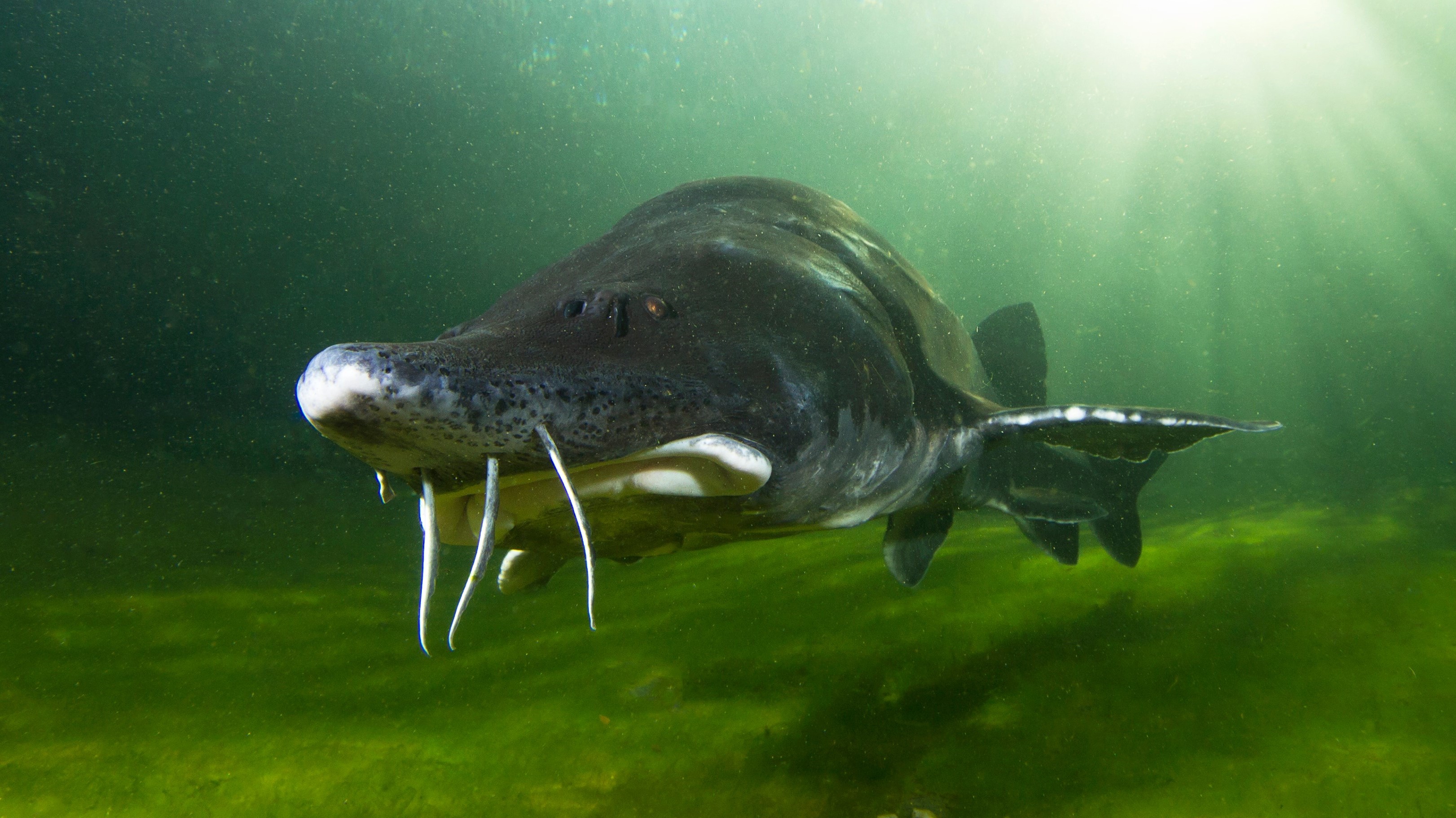What's the biggest freshwater fish in the world?
The biggest fish might not be from the biggest fish species.

It took three biologists to haul a 240-pound (109 kilograms) fish out of the Detroit River in Michigan last month. The nearly 7-foot-long (2.1 meters) "monster' sturgeon," caught and released by the Alpena Fish and Wildlife Conservation Office, could be more than 100 years old. It's a mightily impressive catch for sure, but is it the biggest freshwater fish in the world?
The Detroit River fish is a lake sturgeon (Acipenser fulvescens), and while it is believed to be one of the largest ever caught in the U.S., there are much bigger fish swimming in rivers around the world. According to the U.S. Geological Survey, the planet's largest freshwater fish is the beluga sturgeon (Huso huso), living between Europe and Asia in the Black, Azov and Caspian seas, and the rivers feeding them.
Beluga sturgeon can reach a maximum length of more than 26 feet (8 m), or about four times as long as a king-size mattress, and weigh up to 2.2 tons (2,000 kg, or 2 metric tons), according to the Pan-European Action Plan for Sturgeons, prepared by the World Sturgeon Conservation Society and World Wildlife Fund. When they grow up, belugas are at the top of the food chain, eating fish such as roach and carp, aquatic birds and even seals, according to the International Union for Conservation of Nature (IUCN).
Belugas can live more than 100 years, like lake sturgeon, which gives them plenty of time to grow. "If you live a long time, you've got a lot of time to eat," Phaedra Doukakis, a fishery policy analyst at the National Oceanic and Atmospheric Administration (NOAA), told Live Science.
Related: Do goldfish really have a 3-second memory?
Sturgeon have existed for more than 250 million years and even lived alongside the dinosaurs. The beluga is the biggest of the 27 sturgeon and paddlefish species alive today.
Apart from their long lifespan, it's difficult to say exactly why belugas grow so big. Larger sturgeon individuals probably had greater reproductive success, perhaps because the females can generate more eggs than smaller female fish. Their vast size could also help them catch prey and survive predation interactions, according to Leonardo Congiu, an associate professor of ecology at the University of Padova in Italy.
Get the world’s most fascinating discoveries delivered straight to your inbox.
However, today's beluga sturgeon may not be reaching lengths upward of 23 feet (7 m). "I don't think there are beluga of that size any more," Congiu told Live Science in an email. "The species is under great pressure due to poaching, and probably the large animals have all been caught."
Congiu and his colleagues published a paper in January 2021 about the distribution and genetic diversity of beluga populations in the journal Diversity and Distributions. They aim to reintroduce the fish into Italian rivers, after it became locally extinct due to overfishing and the construction of dams in the country.
Beluga sturgeon are listed as critically endangered on the IUCN Red List of Threatened Species, the category for species most at risk of extinction. Adult females are prized for their fish eggs, which are sold as caviar and valued at more than $3,500/lbs. ($8,000/kg), according to the IUCN.
Doukakis, who is also co-chair of the IUCN Sturgeon Specialist Group, thinks it's possible that there are 23-foot-plus belugas out there, but they would have a significant bounty on their heads. "An old female that achieved that kind of a length could be loaded with caviar and could be a very, very expensive, very lucrative fish to poach," she said.
Sustainably farmed caviar is now available, but Doukakis explained that even if maximum protections were put in place for wild beluga sturgeon, it would take a long time for younger individuals to mature and reach their maximum lengths.
The title for biggest growing sturgeon today may actually belong to the white sturgeon (Acipenser transmontanus), the largest sturgeon in the U.S. In fact, people are probably more likely to see more large white sturgeon than beluga sturgeon, just because white sturgeon are probably better protected, Doukakis said.
Related: How long do most species last before going extinct?
For now, white sturgeon are not threatened with extinction and their population is stable, according to the IUCN. However, like almost all sturgeon species, they are threatened by the construction of dams. Dams prevent sturgeon from swimming upstream to reach their spawning grounds and also alter the environmental conditions of the rivers that sturgeon rely on, according to Doukakis.
Beluga and white sturgeon are called freshwater fish because they are born in freshwater and use it for breeding, but they also occupy saltwater environments. Doukakis prefered to call them freshwater-dependent fish to distinguish them from species that spend their entire lives in freshwater.
What about the biggest fish that only live in freshwater? The Mekong giant catfish (Pangasianodon gigas), native to the Mekong river in Southeast Asia, holds that record. These catfish can grow to 10 feet (3 m) long and have previously been caught weighing 646 lbs. (293 kg), Live Science previously reported. Like beluga sturgeon, these fish are also considered critically endangered by the IUCN, due to dams and overfishing.
Originally published on Live Science.

Patrick Pester is the trending news writer at Live Science. His work has appeared on other science websites, such as BBC Science Focus and Scientific American. Patrick retrained as a journalist after spending his early career working in zoos and wildlife conservation. He was awarded the Master's Excellence Scholarship to study at Cardiff University where he completed a master's degree in international journalism. He also has a second master's degree in biodiversity, evolution and conservation in action from Middlesex University London. When he isn't writing news, Patrick investigates the sale of human remains.



